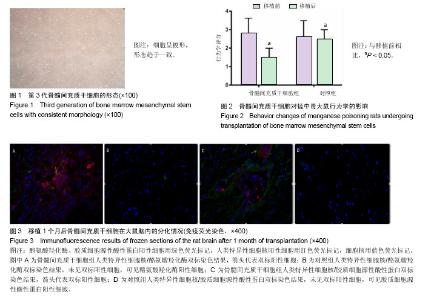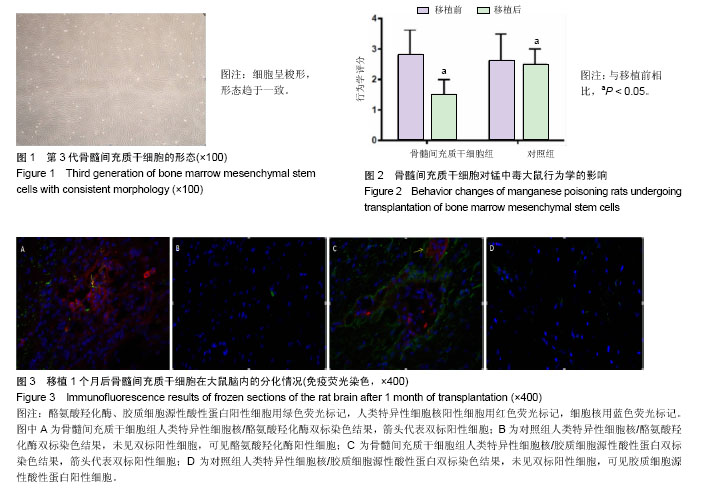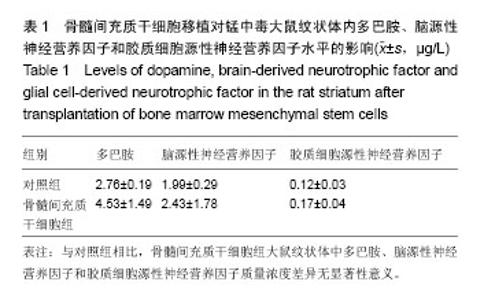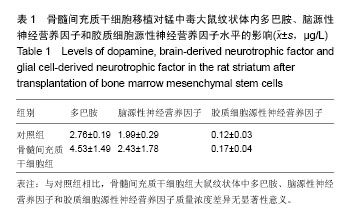| [1] Stanwood GD, Leitch DB, Savchenko V, et al. Manganese exposure is cytotoxic and alters dopaminergic and GABAergic neurons within the basal ganglia. J Neurochem. 2009;110(1): 378-389.[2] Tuschl K, Clayton PT, Gospe SM Jr, et al. Syndrome of hepatic cirrhosis, dystonia, polycythemia, and hypermanganesemia caused by mutations in SLC30A10, a manganese transporter in man. Am J Hum Genet. 2012;90(3):457-466. [3] Xiong N, Yang H, Liu L, et al. bFGF promotes the differentiation and effectiveness of human bone marrow mesenchymal stem cells in a rotenone model for Parkinson's disease. Environ Toxicol Pharmacol. 2013;36(2):411-422. [4] Lee JK, Jin HK, Bae JS. Bone marrow-derived mesenchymal stem cells reduce brain amyloid-beta deposition and accelerate the activation of microglia in an acutely induced Alzheimer's disease mouse model. Neurosci Lett. 2009; 450(2):136-141.[5] Mazzini L, Mareschi K, Ferrero I, et al. Autologous mesenchymal stem cells: clinical applications in amyotrophic lateral sclerosis. Neurol Res. 2006;28(5):523-526.[6] Lin YT, Chern Y, Shen CK, et al. Human mesenchymal stem cells prolong survival and ameliorate motor deficit through trophic support in Huntington's disease mouse models. PLoS One. 2011;6(8):e22924. [7] Karussis D, Kassis I, Kurkalli BG, et al. Immunomodulation and neuroprotection with mesenchymal bone marrow stem cells (MSCs): a proposed treatment for multiple sclerosis and other neuroimmunological/neurodegenerative diseases. J Neurol Sci. 2008;265(1-2):131-135. [8] Ahmed HH, Salem AM, Atta HM, et al. Updates in the pathophysiological mechanisms of Parkinson's disease: Emerging role of bone marrow mesenchymal stem cells. World J Stem Cells. 2016;8(3):106-117. [9] Riecke J, Johns KM, Cai C, et al. A Meta-Analysis of Mesenchymal Stem Cells in Animal Models of Parkinson's Disease. Stem Cells Dev. 2015;24(18):2082-2090. [10] 陈忻,张楠,赵晖,等. 鱼藤酮致帕金森病大鼠行为学与黑质病理损伤的关系[J]. 中国神经精神疾病杂志,2008,34(4):232-234.[11] Han F, Wang W, Chen B, et al. Human induced pluripotent stem cell-derived neurons improve motor asymmetry in a 6-hydroxydopamine-induced rat model of Parkinson's disease. Cytotherapy. 2015;17(5):665-679. [12] Yang F, Liu Y, Tu J, et al. Activated astrocytes enhance the dopaminergic differentiation of stem cells and promote brain repair through bFGF. Nat Commun. 2014;5:5627. [13] Huang CC. Parkinsonism induced by chronic manganese intoxication--an experience in Taiwan. Chang Gung Med J. 2007;30(5):385-395.[14] de Bie RM, Gladstone RM, Strafella AP, et al. Manganese-induced Parkinsonism associated with methcathinone (Ephedrone) abuse. Arch Neurol. 2007;64(6): 886-889.[15] Guilarte TR, Burton NC, McGlothan JL, et al. Impairment of nigrostriatal dopamine neurotransmission by manganese is mediated by pre-synaptic mechanism(s): implications to manganese-induced parkinsonism. J Neurochem. 2008; 107(5):1236-1247. [16] Liu X, Sullivan KA, Madl JE, et al. Manganese-induced neurotoxicity: the role of astroglial-derived nitric oxide in striatal interneuron degeneration. Toxicol Sci. 2006;91(2): 521-531.[17] Dorman DC, Struve MF, Clewell HJ 3rd, et al. Application of pharmacokinetic data to the risk assessment of inhaled manganese. Neurotoxicology. 2006;27(5):752-764. [18] Anderson JG, Cooney PT, Erikson KM. Inhibition of DAT function attenuates manganese accumulation in the globus pallidus. Environ Toxicol Pharmacol. 2007;23(2):179-184.[19] Lu L, Zhao C, Liu Y, et al. Therapeutic benefit of TH-engineered mesenchymal stem cells for Parkinson's disease. Brain Res Brain Res Protoc. 2005;15(1):46-51. [20] Lindvall O, Wahlberg LU. Encapsulated cell biodelivery of GDNF: a novel clinical strategy for neuroprotection and neuroregeneration in Parkinson's disease? Exp Neurol. 2008;209(1):82-88. [21] Du Y, Zhang X, Tao Q, et al. Adeno-associated virus type 2 vector-mediated glial cell line-derived neurotrophic factor gene transfer induces neuroprotection and neuroregeneration in a ubiquitin-proteasome system impairment animal model of Parkinson's disease. Neurodegener Dis. 2013;11(3):113-128. [22] Hoban DB, Howard L, Dowd E. GDNF-secreting mesenchymal stem cells provide localized neuroprotection in an inflammation-driven rat model of Parkinson's disease. Neuroscience. 2015;303:402-411. [23] Peaire AE, Takeshima T, Johnston JM, et al. Production of dopaminergic neurons for cell therapy in the treatment of Parkinson's disease. J Neurosci Methods. 2003;124(1):61-74.[24] Deierborg T, Soulet D, Roybon L, et al. Emerging restorative treatments for Parkinson's disease. Prog Neurobiol. 2008; 85(4):407-432.[25] Ma S, Xie N, Li W, et al. Immunobiology of mesenchymal stem cells. Cell Death Differ. 2014;21(2):216-225. [26] Boomsma RA, Geenen DL. Mesenchymal stem cells secrete multiple cytokines that promote angiogenesis and have contrasting effects on chemotaxis and apoptosis. PLoS One. 2012;7(4):e35685. [27] Hung SC, Pochampally RR, Chen SC, et al. Angiogenic effects of human multipotent stromal cell conditioned medium activate the PI3K-Akt pathway in hypoxic endothelial cells to inhibit apoptosis, increase survival, and stimulate angiogenesis. Stem Cells. 2007;25(9):2363-2370. [28] Chang MC, Tsao CH, Huang WH, et al. Conditioned medium derived from mesenchymal stem cells overexpressing HPV16 E6E7 dramatically improves ischemic limb. J Mol Cell Cardiol. 2014;72:339-349. [29] Burlacu A, Grigorescu G, Rosca AM, et al. Factors secreted by mesenchymal stem cells and endothelial progenitor cells have complementary effects on angiogenesis in vitro. Stem Cells Dev. 2013;22(4):643-653. [30] Li GH,Yu FB,Gao HJ,et al.Bone marrow mesenchymal stem cell therapy in ischemic stroke: mechanisms of action and treatment optimization strategies. Neural Regen Res. 2016;11 (6): 1015-1024.[31] Windmolders S, De Boeck A, Koninckx R, et al. Mesenchymal stem cell secreted platelet derived growth factor exerts a pro-migratory effect on resident Cardiac Atrial appendage Stem Cells. J Mol Cell Cardiol. 2014;66:177-188. |



